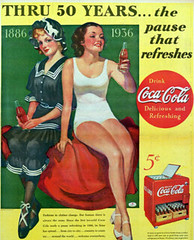
PREV ARTICLE
NEXT ARTICLE
FULL ISSUE
PREV FULL ISSUE
QUERY: EVER HEARD OF THE 7 1/2 CENT "COCA COLA" COIN?
On Thursday morning I heard something interesting on National Public Radio. The story was about how Coca-Cola had kept the price of a bottle of Coke constant at 5 cents for an amazing 70 years. In the 50s they finally needed to raise the price but didn't want to double it to a dime. The piece said they lobbied President Eisenhower and Congress for a 7 1/2 cent coin. Has anyone ever heard of this? Here's a transcript of the story.
-Editor
And yet: In 1886, a bottle of Coke cost a nickel. It was also a nickel in 1900, 1915 and 1930. In fact, 70 years after the first Coke was sold, you could still buy a bottle for a nickel. Three wars, the Great Depression, hundreds of competitors — none of it made any difference for the price of Coke. Why not? In 1899, two lawyers paid a visit to the president of Coca-Cola. At the time, Coke was sold at soda fountains. But the lawyers were interested in this new idea: selling drinks in bottles. The lawyers wanted to buy the bottling rights for Coca-Cola. The president of Coca-Cola didn't think much of the whole bottle thing. So he made a deal with the lawyers: He'd let them sell Coke in bottles, and he'd sell them the syrup to do it. According to the terms of the deal, the lawyers would be able to buy the syrup at a fixed price. Forever. Bottled drinks, of course, took off. And Coca-Cola was in a bind. If the bottlers or a corner store decided to raise the price of a bottle of Coke, Coca-Cola wouldn't get any extra money. So, if you're Coca-Cola, you want to somehow keep the price down at 5 cents so you can sell as much syrup as possible to the bottlers. What do you do? "One thing you do is blanket the entire nation with Coca-Cola advertising that basically has '5 cents' prominently featured," Young says. The company couldn't actually put price tags on the bottles of Coke saying "5 cents." But it could paint a giant ad on the side of a building right next to the store that says, "Drink Coca-Cola, 5 Cents." That contract with the bottlers eventually got renegotiated. But the price of Coke stayed at a nickel. That was partly due to another obstacle: the vending machine. The Coca-Cola vending machines were built to take a single coin: a nickel. Levy says the folks at Coca-Cola thought about converting the vending machines to take a dime. But doubling the price was too much. They wanted something in between. So they asked the U.S. Treasury to issue a 7.5-cent coin. At one point, the head of Coca-Cola asked President Eisenhower for help. (They were hunting buddies.) No luck. In the end, inflation killed the nickel Coke. The price of the ingredients rose. In the late 1940s, some stores sold Cokes for 6 cents. The last nickel Coke seems to have been in 1959.
To read the complete article, see:
Why Coke Cost A Nickel For 70 Years
(www.npr.org/blogs/money/2012/11/15/165143816/ I checked in with researcher Roger Burdette, who writes: I'm aware of several efforts to have odd-denomination coins minted, but I have not collected any specific information on the Coke Co. proposal. There are several mint files in NARA College Park dealing with coin proposals. Someone might want to check them.

Wayne Homren, Editor The Numismatic Bibliomania Society is a non-profit organization promoting numismatic literature. See our web site at coinbooks.org. To submit items for publication in The E-Sylum, write to the Editor at this address: whomren@gmail.com To subscribe go to: https://my.binhost.com/lists/listinfo/esylum All Rights Reserved. NBS Home Page Contact the NBS webmaster 
|
